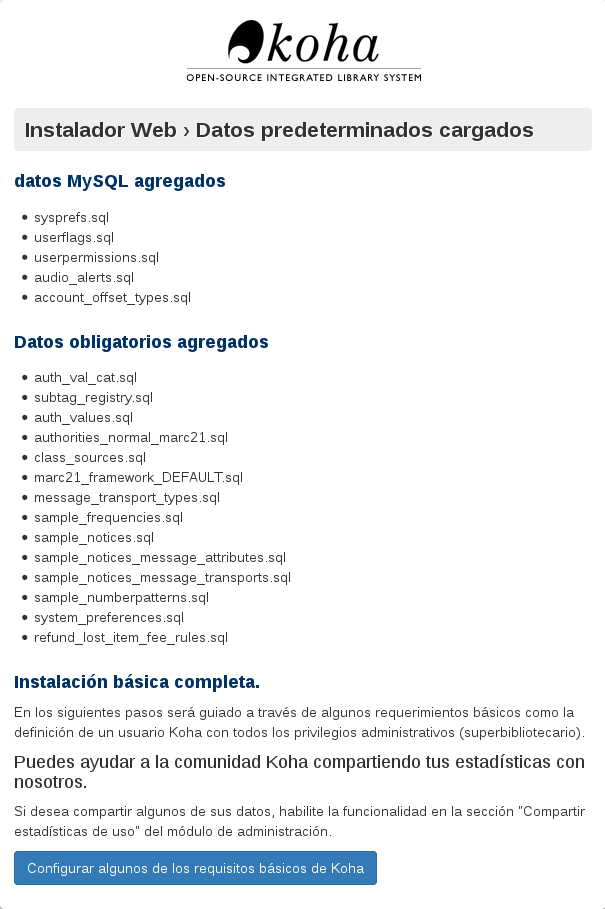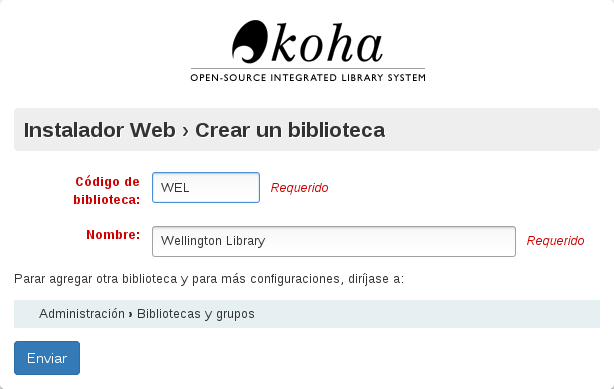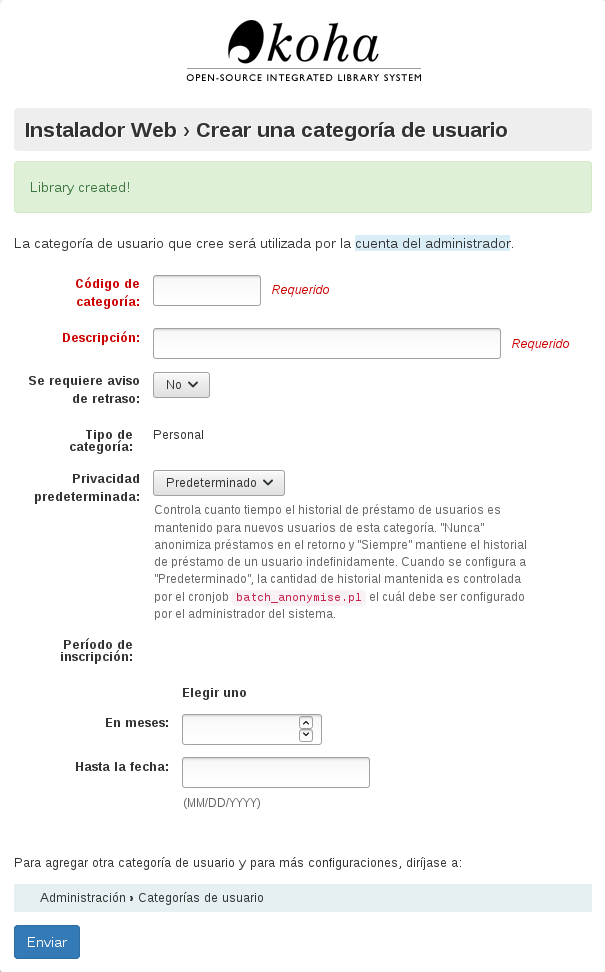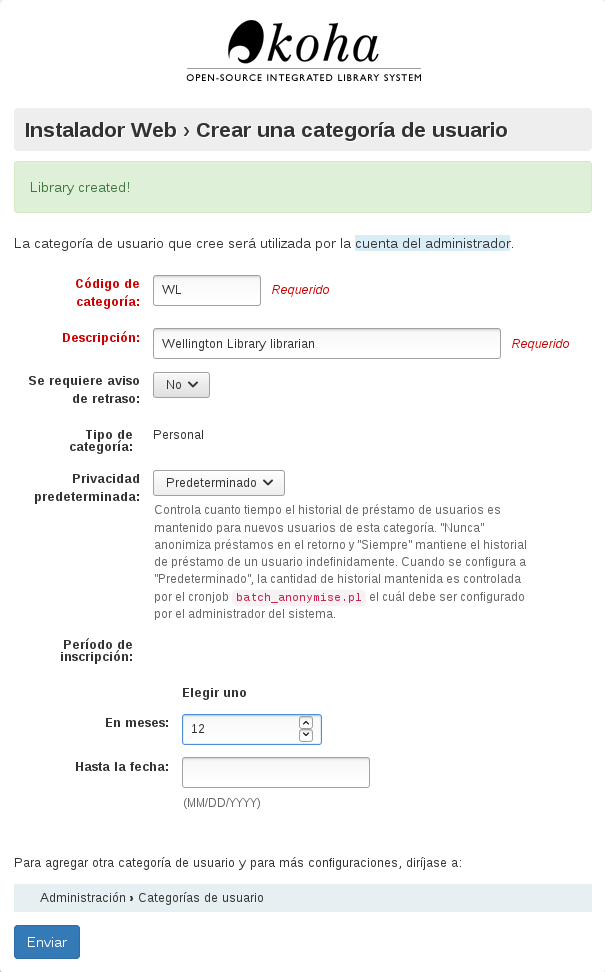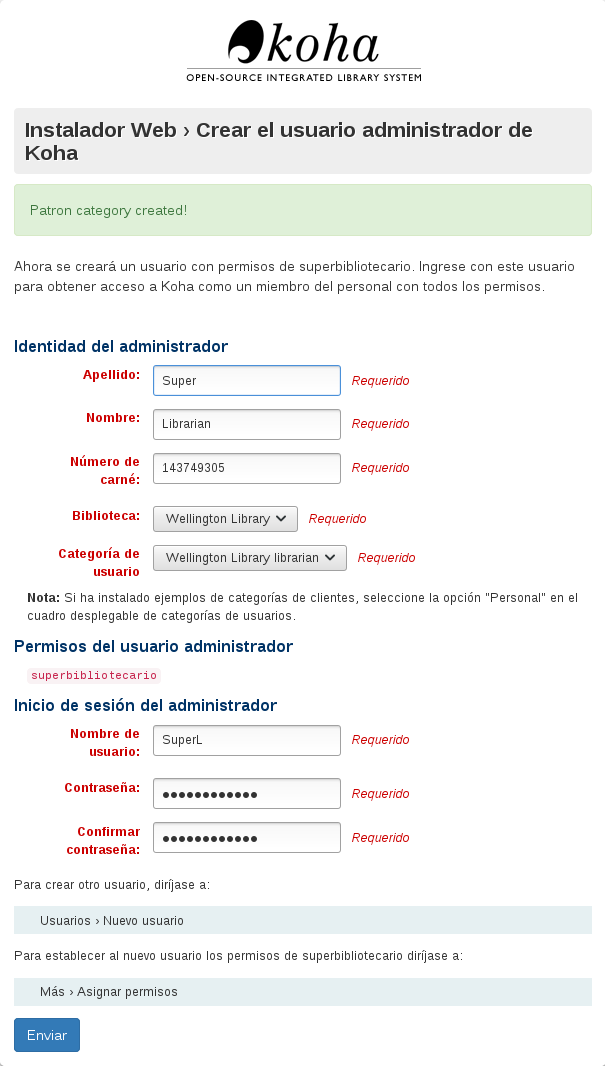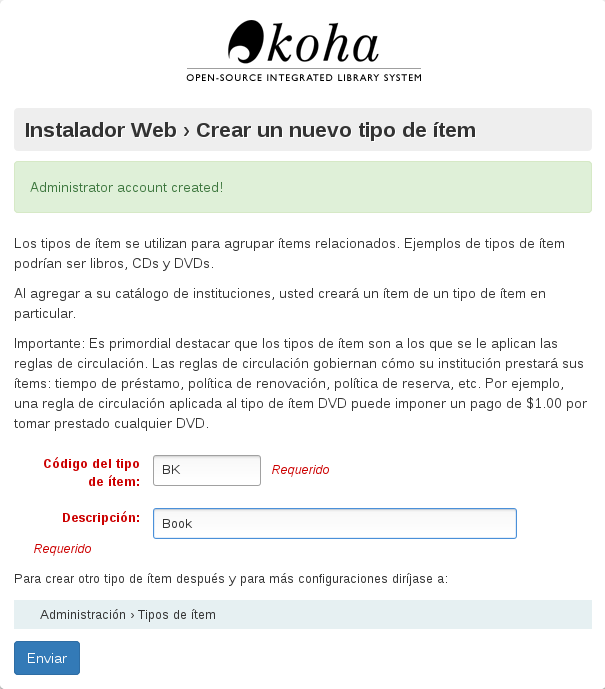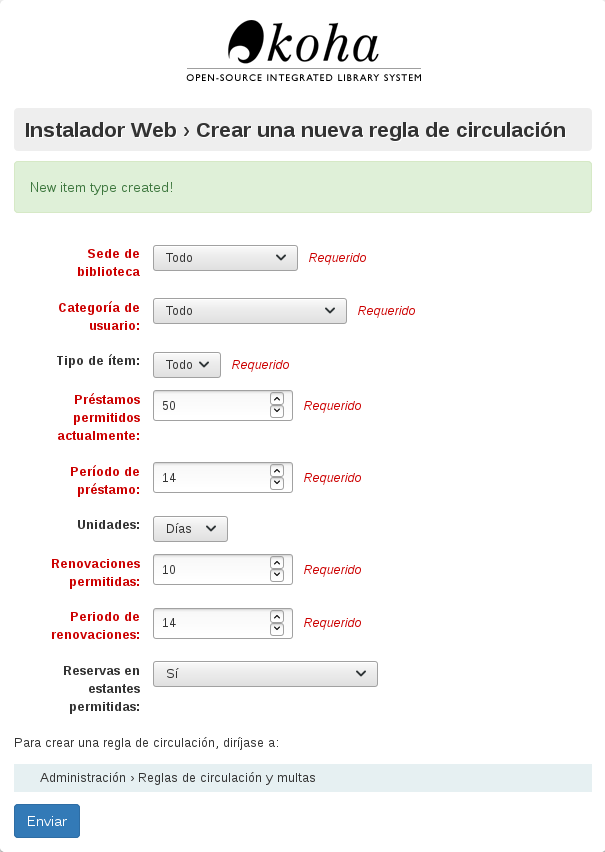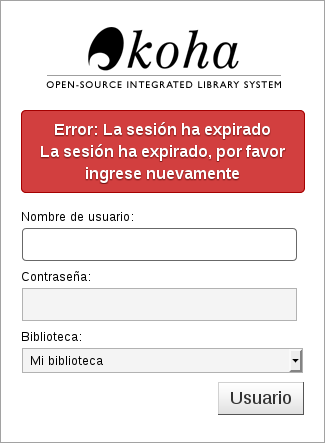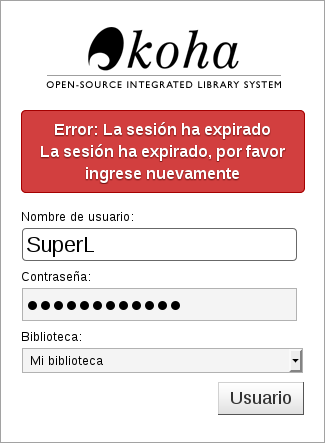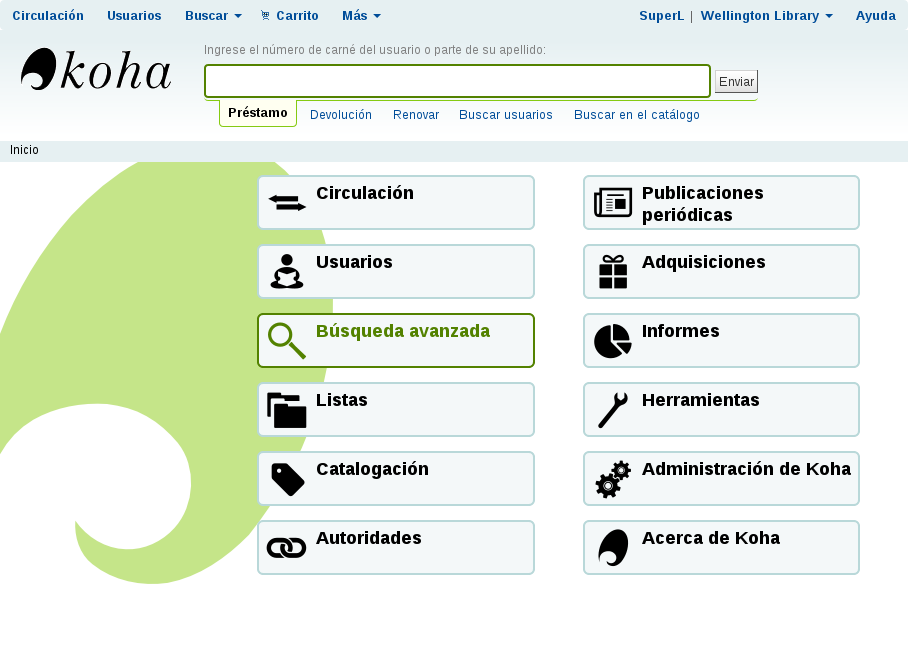Introducción al Proceso de Instalación de Koha¶
This is the Koha Installation Manual
El proceso de instalación del Sistema de Gestión Bibliotecaria Koha utiliza 2 herramientas:
- Instalados Web
- Herramienta de integración inicial
Esta documentación describirá estas dos herramientas.
¿Qué es el instalador web de Koha?¶
El instalador web prepara las tablas de la base de datos que guardan toda la información con la que trabajas en Koha, por ejemplo las bibliotecas, usuarios e ítems.
El instalador web comienza con una página de inicio de sesión para que ingreses las credenciales de la cuenta de administrador de base de datos.
A continuación, el instalador creará las tablas y las llenará con datos. El próximo paso en el proceso es preparar la configuración obligatoria de inicio, a través de la herramienta de Incorporación.
¿Qué es la herramienta de Integración a Koha?¶
La herramienta de integración se asegura que se tiene al menos una biblioteca, categoría de usuario, usuario, tipo de material y política de circulación antes de que comience a utilizar Koha.
Si ha instalado datos de ejemplo para biblioteca, categoría de usuario, y/o tipo de ítem entonces las páginas para crear estos serán omitidas.
Sin embargo, usted siempre tendrá que crear un usuario(para iniciar sesión en la interfaz administrativa al final de la herramienta de instalación) y una política de circulación.
Instalador Web¶
Inicio de sesión de instalador Web¶
Inicio de sesión del Instalador Web
Esta pantalla de inicio de sesión es la primera que aparece al instalar Koha.
Inicio de sesión del Instalador Web
- Nombre de versión de Koha: Esto desplegará el número de versión que está instalando.
- Nombre de usuario: Este es el nombre de usuario del administrador de la base de datos el cual es * koha_kohadev* por defecto.
- Contraseña: Esta es la contraseña del administrador de base de datos que es password por defecto.
- Iniciar sesión: Seleccione este botón para iniciar sesión
Selección de idioma¶
Pantalla de Iniciar Instalador
Esta es la primer pantalla del instalador web.
imagen1166
pantalla de inicio de instalador Web
- Caja de selección de idioma: En esta se especifica el lenguaje en el que quieres que se muestre Koha.
Nota
Instalando otros lenguajes que tienen traducciones para el instalador (DE o FR, por ejemplo) permitirá usar esos lenguajes para el instalador web.
- Haga clic en el botón Continuar al siguiente paso para cargar la siguiente etapa del instalador web.
Instalador de módulos Perl instalado¶
Esta pantalla te indica que el instalador tiene todas las dependencias necesarias, para crear la base de datos en la siguiente pantalla.
Módulos Perl instalados
Clic en el botón Continuar al siguiente paso para cargar la siguiente etapa del instalador web.
Configuración de la base de datos¶
Esta pantalla te indica los ajustes de la base de datos y te solicita que los confirmes dando clic en el botón Continúe al siguiente paso.
Nota
Para la mayoría de usuarios estos ajustes deberían ser correctos, si no entonces deberás contactar a tu técnico de soporte.
imagen1168
Configuración de la base de datos
- Ajustes de la Base de Datos: Verifica que estos ajustes de base de datos son correctos.
- Clic en el botón *Continúe al siguiente paso*¨para confirmar los ajustes de la base de datos
Conexión Establecida
Después de dar clic en el botón Siguiente la conexión a la base de datos está confirmada:
Se ha establecido la conexión a la base de datos
- Mensaje de conexión establecida: Esto te indica que la base de datos ha sido creada correctamente.
- Clic en el botón Continuar al siguiente paso para cargar el siguiente paso
Nota
Si tu tiene dificultades de conexión en este paso, el instalador no continuará. Vuelva a verificar su información de conexión en su archivo koha-conf.xml, y verifique que los permisos y credenciales en la base de datos misma, son correctos.
Listo para llenar las tablas con datos¶
Esta pantalla le indica que todo está listo para crear las tablas de la base de datos en la siguiente pantalla.
Base de datos lista para datos
Clic en el botón Continuar al siguiente paso para cargar el siguiente paso
Nota
Este paso puede llevar un tiempo. Por favor, sea paciente.
Tablas de la base de datos creadas¶
Tablas de la base de datos creadas
Dar clic en el botón Continúe al siguiente paso
Preparado por las configuraciones básicas¶
Esta pantalla conduce a la instalación de configuraciones básicas que son necesarias para usar Koha.
Preparado por las configuraciones básicas
Dar clic en el botón Continúe al siguiente paso
Select MARC flavour¶
Debe elegir su variante MARC (formato en el que desea que los registros bibliográficos (catálogo) se almacenen en la base de datos) en ésta pantalla:
Select MARC flavour
- Unimarc: Utilizado generalmente en países europeos (excepto Reino Unido) tales como Italia.
- MARC21: Seleccionado por defecto ya que es el más utilizado que UNIMARC a nivel global.
- Click the Continue to the next step button to confirm your choices
Configuración de MARC21 y UNIMARC¶
Nota
En la pantalla anterior debe haber seleccionado MARC21 o UNIMARC como su variante MARC. Esta página describe ambos.
preparación de MARC21¶
preparación de MARC21
- Default MARC21 Standard Authority Types: An authority type is a template of an authority record (stores the search fields used to search an institutions catalog for an item). This option will install sample authority types.
- Default MACR21 bibliographic framework: Following on from the MARC21 selection in the previous screen selecting this checkbox (and the Import button) will actually setup the MARC21 bibliographic framework as the desired MARC flavour.
- Selected matching rules for MARC21 bibliographic records: The MARC21 matching rules are used to find all the information about specific bibliographic records using the authority type search values.
- “FA”, a “Fast Add” minimal MARC21 framework suitable for ILL, or on the fly cataloging: The FA MARC framework displays fewer fields, and allows for faster cataloguing on the fly. Select this checkbox to install this minimal framework.
- Sample MARC21 bibliographic frameworks for some common types of bibliographic material: This installs the template you will use to create items.
- Default Koha system authorised values: This installs mandatory authorised values that every Koha installation needs.
- Default classification sources and filling rules: This will insert several common library classification sources such as dewey decimal.
- Defines default message transports for email and sms: This provides the option to the user of being able to change how the library contacts them. They can choose from the following: email address, printed message, sms, or phone call. Notices will not work without these.
- Patron attributes: This does not install any data, and it needs to be removed.
- Sample frequencies for subscriptions: For items that arrive on a regular and predictable basis (e.g. monthly magazines), installing sample frequencies is useful because you can simply select a pre-installed sample frequency when you create the item.
- Sample notices: This inserts sample notices into the database, meaning all you have to do is customize these sample notices before you use them. Creating these by hand can be very time consuming and error prone.
- Defines default messages for the enhanced messaging configuration: The enhanced messaging configuration lets the user choose what messages they receive from the institution. Selecting this will insert sample message types for the Due, Predue, and Advance notice message types.
- Defines default message transports for sending item due messages and advance notice messages through email and SMS: This inserts the SMS and email transport types. Mandatory if you want to send notices by email or SMS.
- Sample numbering patterns for subscriptions: This option will install sample numbering patterns, saving you having to manually insert them for magazines and other periodicals.
- Some basic default authorised values for library locations, item lost status, etc. You can change these at any time after installation: This installs authorised values, which filter user inputs, to make sure they match specified criteria before the library or other object is created.
- CSV profiles: Using Koha you can export items. The CSV profile defines how you want to export the item(s). CSV/Tab exports will not work without these.
- Coded values conforming to the Z39.71-2006 holdings statements for bibliographic items: Not required to use Koha. A holding statement tells the user if the library has a specific item and where it is located. Selecting will install sample code values for items in the holding statements.
- MARC code list for relators: Not required to use Koha. A relator is a person who was invloved in the development of the item (e.g. author). Selecting this will insert sample relator records into the database.
- Some basic currencies with USA dollar as default for ACQ module: Install US dollar, Great British Pound, Canadian Dollar and Euro currencies. Set the US dollar as the default acquisition currency. Not installing these will mean that a currency will need to be defined before Acquisitions can be used.
- Useful patron attribute types: Not required to use Koha. Patrons have a barcode which identifies them. By clicking this checkbox your making sure that this patron barcode is displayed on the patron summary screen.
- Sample patron types and categories: Not required to use Koha. Selecting this will install sample patron categories into the database. This will mean the Create patron category step in the onboarding tool is skipped.
- Sample label and patron card data: Not required to use Koha, but recommended for most new installs. Selecting this will install sample data for labels and patron cards and will make it easier to create a labels and patron cards in the future.
- Sample holidays: Sunday, Christmas, New Year’s Not required to use Koha. Selecting this will insert sample repeatable public holidays (e.g. Christmas) into the database.
- A set of default item types: Not required for Koha. Selecting this will insert sample item type data into the database, meaning Create Item type step in the onboarding tool will be skipped.
- Sample Libraries: Not required for Koha. Selecting this will insert sample libraries into the database. Developers will often want this for demo or development purposes. Selecting this means the Create library step in the onboarding tool will be skipped.
- Sample news items: Not required for Koha. Selecting this will insert sample news items that are displayed on the OPAC (Online Public Access Catalog) and staff client into the database.
- Sample patrons: Not required for Koha. Patrons are the people who use the Koha Library Management System, for example: library users and staff. Selecting this will insert a number of sample patrons into the database. Developers will often want this for demo or development purposes.
- Sample quotes: Not required for Koha. Quotes of the day can be displayed to library users on the OPAC (Online Public Access Catalog) interface. Selecting this will install a few library related sample quotes.
- Allow access to the following servers to search and download record information: Not required to use Koha, but recommended for most new installs. Selecting this configures Koha to allow access to a selection of Z39.50 targets, which allow searching the target servers for MARC21 records to import them into your Koha instance. This can avoid the need to manually input all record information manually, or greatly speed up the process.
- Click the Import button to install the default and selected data values.
Unimarc setup¶
There are only 2 data values in the Unimarc advanced setup which are unique:
- Authority Structure for UNIMARC in English
- Default UNIMARC bibliographic framework in English
Nota
Optional values are the same for both Unimarc and MARC21, therefore their definition will not be repeated.

Unimarc setup
- Authority structure for UNIMARC in English: Authority records store the search terms used to find items in the database. Unlike MARC21, when using Unimarc the authority structure needs to be compatible with Unimarc. Selecting this option makes it compatible.
- Default UNIMARC bibliographic framework in English: In the previous screen you clicked to use the Unimarc flavour, now by selecting this option you are confirming you want to use that framework.
- Click the Import button to install the sample data
Selected data added¶
After you have clicked the Import button in either the MARC21 or UNIMARC setup screen this screen will appear. It shows you if the selected/default data values were successfully inserted into the database.
Selected data added
- Optional data added: If you selected an optional data value then it will be displayed here. If you did not choose any optional data value then the optional data added title will not be displayed.
- Mysql data added: These data values will always be installed and consequently displayed on this screen.
- Mandatory data added: Same as above.
- Installation message: Tells you if the Koha database was successfully created ready for you to use the onboarding tool.
- Click the Set up some of Koha’s basic requirements button to go to a redirection screen, which in turn will take you to the onboarding tool.
Redirect to onboarding tool¶
If you wait for around 10 seconds this screen should redirect you to the onboarding tool start screen.
Redirect to onboarding tool
Nota
If after waiting you are not redirected select the link pointed out by the arrow in the above screenshot.
Herramienta de integración inicial¶
Create a library¶
The installer will prompt to create the first library or branch if the sample libraries were not installed.
A library in Koha is the digital representation of a «physical» place. More libraries can be added later by going to Administration -> Libraries and groups.
Create library
- Library code: code consisting of up to 10 letters.
- Name: Official name of the library, as it is commonly known.
- Create more libraries: If more libraries are required, or changes need to be made to this freshly created library, go to Administration->Libraries and groups
- Click the Submit button to create a library.
Por ejemplo:
Create library example
Library code: The regular expression that filters the acceptable inputs for library code only accepts up to 10 letters.
Create a patron category¶
All patrons in Koha must have a patron category. The patron category is like a jelly mold; multiple individual patron accounts can share common characteristics, such as circulation rules, notice frequency, holds allowed, and much more. Koha requires at least one patron category in order to add patrons.
A patron category requires:
- Código de categoría
- Descripción
- Overdue notice required
- Category type
- Privacidad predeterminada
- Enrolment period: In months OR Until date
Create a patron category
- Library creation message: Indicates whether the library was created successfully
- Category code: Code consisting of up to 10 letters.
- Description: Sentence describing what the patron category is.
- Overdue notice required dropdown button: Set by default to “No”. This specifies if you want the patron category to receive overdue notices.
- Category type: This makes the category created a staff member.
- Default privacy: Set by default to “Default”. The Default privacy controls the amount of time that the reading history of the patron is stored for.
- Enrolment period-In months: This is the number of months that the patrons created from this patron category are enrolled for.
- Enrolment period-Until date: Select a date from the interactive datepicker calendar icon which appears when you click on this input box. The date you choose will be the enrolment end date for patrons created from this patron category.
- Path to create patron category: More patron categories can be created or altered by going to Administration -> Patron categories
- Click the Submit button to create the patron category.
Por ejemplo:
Create a patron¶
A superlibrarian patron user is required to log into the Koha staff interface, once the onboarding process has been completed.
Nota
It is very important to document the username and password created here as they are the account credentials required to login as an administrator (superlibrarian) of Koha.
You will need to input/select:
Apellidos
First Name
Número de Carné
Biblioteca
Categoría de usuario
Nombre de usuario
Contraseña
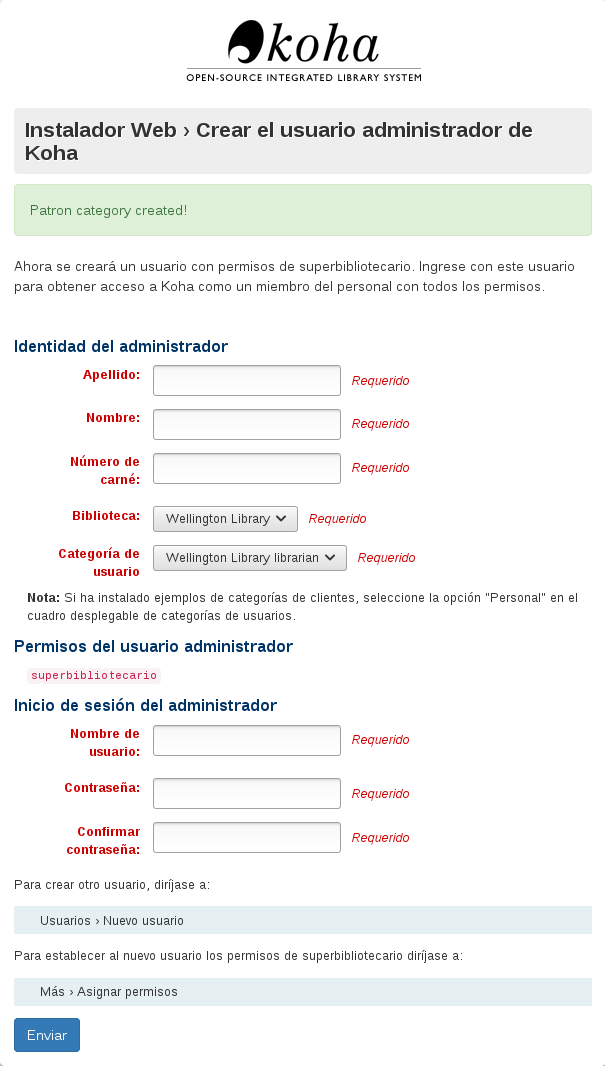
Create a patron
- Patron category creation message: This indicates that if the patron category was created successfully.
- Surname: Surname, or something descriptive
- First name: First name, or something descriptive
- Card Number: This number must be unique
- Library dropdown box: If a library has been created using this onboarding tool, it will be the only option. Otherwise select a random library from the sample libraries installed by the web installer.
- Patron category dropdown box: If a patron category was created using this onboarding tool, it will be the only option. Otherwise select the Staff patron category.
- Superlibrarian permission: This non-editable setting allows access to all librarian and web based Koha administration tasks in the staff interface. This user is the most powerful user in any Koha, so protect the credentials well.
- Username: The username to log into the staff interface and OPAC (Online Patron Access Catalogue) with.
- Password: A password consisting of letters, numbers, and spaces only which is greater than 8 characters.
- Confirm password: Repeat the above password again
- Click the Submit button to create the patron account
- Path to create patron: Patron’s can be created or altered by going to Patrons->New patron
- Assign patron permissions: After creating a patron go More->Set permissions to assign permissions.
Por ejemplo:
Create a patron example
Create a Item type¶
If you did not install sample item types in the web installer then this screen will be displayed.
As with the patron category the item type is basically a template which you use to make multiple items with common characteristics.
You need to input:
Item type code
Descripción
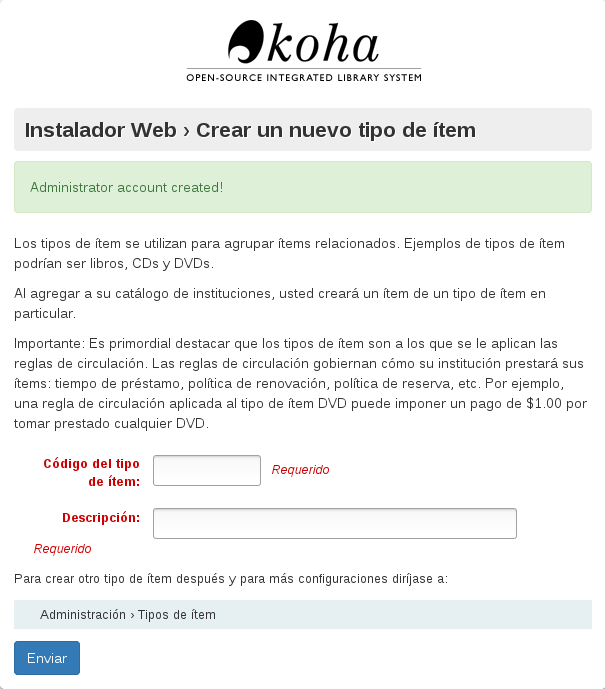
Create item type
- Administrator account creation message: Indicates if the administrator patron was created successfully
- Item type code: Code consisting of up to 10 letters
- Description: Sentence describing what the item type is.
- Path to create item type: Item types can be created or altered by going to Administrator->Item types
- Click the Submit button to create the item type
Por ejemplo:
Create item type example
Nota
The regular expression filtering Item Type code input will only accept letters.
Create a Circulation Rule¶
This screen will always be displayed no matter what sample data you installed with the web installer.
Here you are creating a rule which applies the pre-defined organisational decisions of your library as to what restrictions you place on patrons borrowing items.
Create circulation rule
Nota
Numbers are the only valid input for all input fields in this form.
- Item type creation message: Indicates if the item type was created successfully
- Library branch dropdown box: This is the library (or libraries) you want to apply the circulation rule to. By default it is set to All, however you can select a singular library to apply the rule to from the dropdown box.
- Patron categories dropdown box: This is the patron categories you want to apply the circulation rule to. As with Library branch it is set to All by default but more options are avaliable.
- Item type dropdown box: This is the item types that you want the circulation rule to apply to. Again more options are avaliable than the default selected All option.
- Current checkouts allowed: This is the number of items allowed from the selected library, for selected patron categories and of the selected item type. Set to 50 by default.
- Loan period: Number of days or hours that an item is allowed out for. Set to 14 by default.
- Units dropdown box: Set by default to Days, the unit selecting in this field is applied to the numerical values written into Loan Period and Renewals Period
- Renewals Allowed: Number of times a item can be renewed. Set to 10 by default.
- Renewals Period: Number of days or hours that a renewal lasts for. Set to 14 by default.
- On shelf holds allowed dropdown box: If items can be held whilst they are on the shelf.
- Path to create circulation rule: Circulation rules can be created or altered by going to Administration -> Circulation and fine rules
- Click the Submit button to create the circulation rule.
Onboarding tool complete¶
This page tells you if the circulation rule was created successfully, and that the Koha installation is complete
- Web installer message: Indicates if the web installation is complete
- Circulation rule creation message: Indicates if the circulation rule was created successfully.
- Start using Koha: Click to login to Koha using the Koha administrator account you created using the onboarding tool.
Login to access staff interface¶
You have now finished using the onboarding tool and can log into the staff interface using the patron account credentials you created in the onboarding tool
Login screen
- Username: Enter the username you created for the patron
- Password: Enter the password you created
- Library: This is the library staff interface you want to log into. The options are either: My library or the library you installed/created. Leaving the default selected option of My library is fine to log in with first time.
- Click the Login button to access the staff interface
Por ejemplo:
Login example
Staff interface¶
The staff interface should now appear
Staff interface
Ver también
For more information about how to use the staff interface, please visit https://koha-community.org/documentation/

